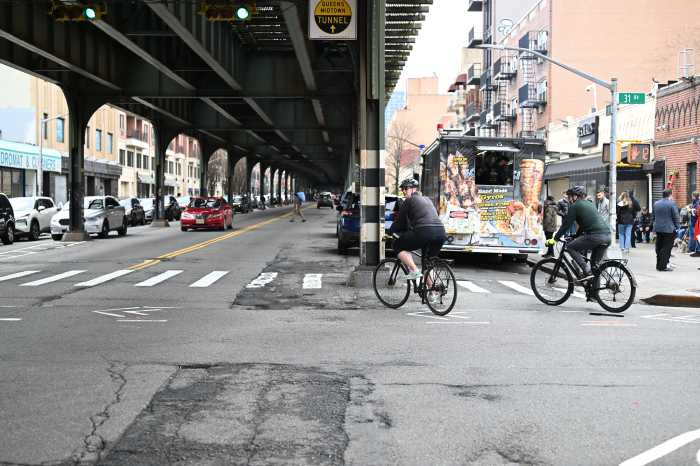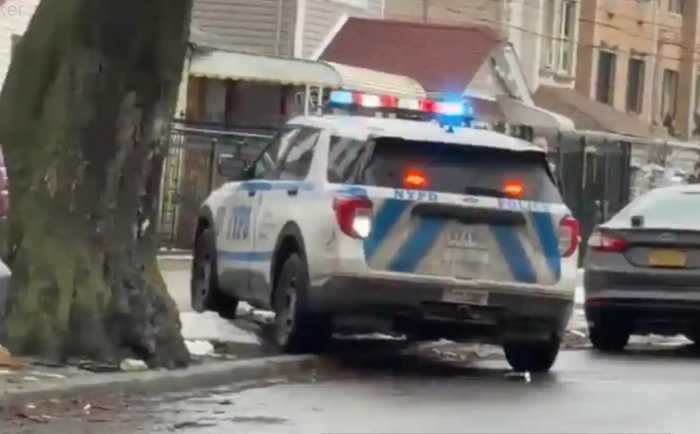By James DeWeese
Ask Seymour Portes what’s new at the Jackson Heights-Roosevelt Avenue subway and bus station and his answer’s simple.
“This is it,” Portes said as he stood, bathed in natural light, overlooking the station’s expansive vestibule like a doting dad and chatting with part of the construction management team that is responsible for the station’s first major overhaul in 71 years.
But Portes, the MTA program manager for capital projects and station rehabilitation, was not just talking about the entranceway or the new banks of turnstiles — through which 42,000 people pass every day, according to MTA estimates. He was talking about the whole kit and caboodle: a $132 million redesign and rehabilitation project for the city’s third busiest subway station.
The MTA said the project is 42 percent complete, and although there is plenty of construction dust, the main entranceway has already got the light and airy feel of some European transportation hubs, thanks to the banks of translucent glass framed by green-colored steel beams that form the station’s walls. New clusters of halogen lamps will do the rest.
When the overhaul is complete, all elevators will be fully accessible for disabled riders, passageways and street walkways will be widened and passengers waiting for the No. 7 line will not have to worry about inclement weather: Canopies will run the entire 450-foot length of the platform as opposed to the 300 feet they cover now.
Portes said the Transit Authority hopes to complete the project, which was designed by Vollmer Associates and Fox and Fowle Architects, by January 2005, 11 months ahead of schedule.
When everything is done, solar panels will sit atop the No. 7-line canopy and the roof of the soon-to-be-rebuilt bus depot to help meet some of the station’s power needs. The complex is one of the first environmentally friendly “green” stations in the city, said Talib Lokhandwala, MTA’s construction manager for the site.
Construction teams also salvaged as much as they could of the buildings that once sat on the site, Portes said.
“We recycled,” chimed in Victor Paterno, project manager for Slattery and Skanska, the contractor in charge of construction.
“In Queens, it’ll be the nicest station,” Portes said. But the project, for which Portes said Albany is footing the bill, has not been without its headaches for some of 14 million or so people who use the station every year.
“It’s terrible,” 28-year-old Jackson Heights resident Paolo Prada said. “It’s very dirty.”
Prada said he takes the train to and from the Jackson Heights station about 10 times a week. “A lot of times there aren’t signs,” Prada added.
As he spoke, a woman wandered by muttering: “Where’s the A train?” in search of a line that does not run to the Jackson Heights.
During just under 10 minutes of observation, more than a few riders craned their necks around corners, looking for the No. 7 line. A handwritten sign — Magic Marker on cardboard — hung at one entrance reading “Take Flushing (7) to Junction Blvd. for Manhattan Service !!”
Portes dismissed concerns about the signs at the sometimes confusing hub where the 7, E, F, R and V trains meet buses destined for the nether-regions of Queens County.
“I don’t think it’s a question of signage,” Portes said. “It’s just that it’s a new area to people.”
Portes said the MTA will be renovating other stations in Queens in the coming months and years. The next capital improvement program request submitted to Albany will be for $15 billion, Portes said. The budget would include money for the rehabilitation of 10 stations on the Liberty Avenue line in Queens, Lokhandwala said.
Stations like the Jackson Heights-Roosevelt Avenue station will not be a dime a dozen, though. Future rehabilitation projects — the MTA’s next stop in Queens is 71st Street-Continental Avenue, Portes said — will also be tailored to the specific area.
“Just like every human being is different, every station is different,” Portes said. “We have to maintain their integrity.
Reach reporter James DeWeese at 718-229-0300, Ext. 157., or by e-mail at news@timesledger.com.


































